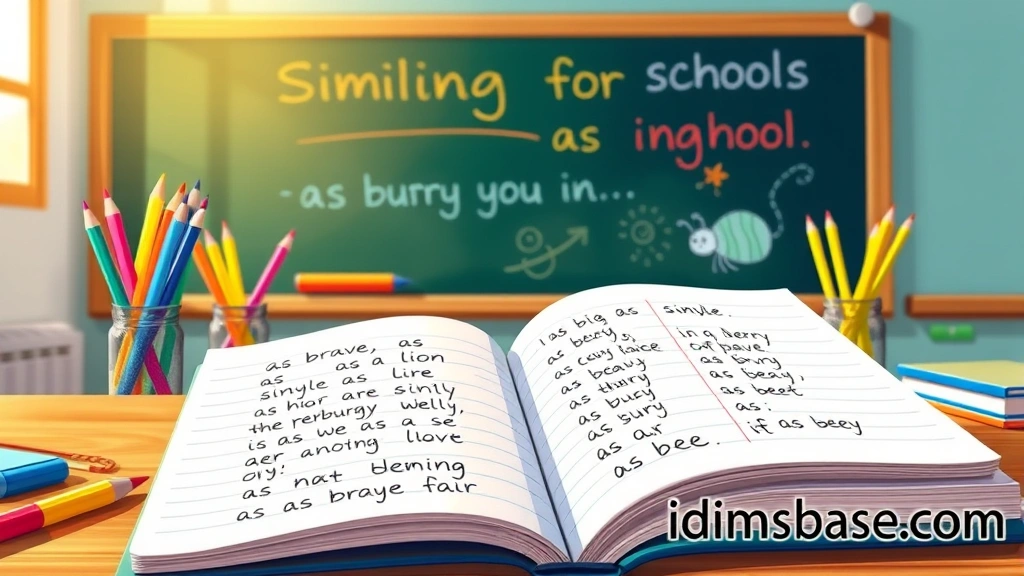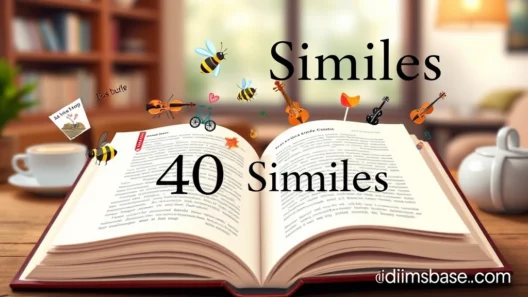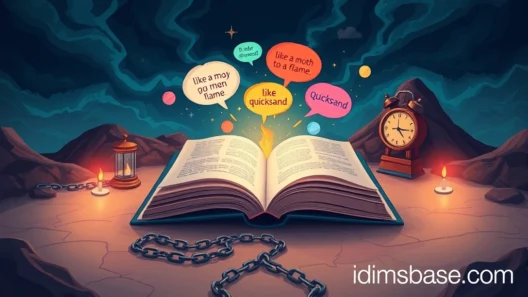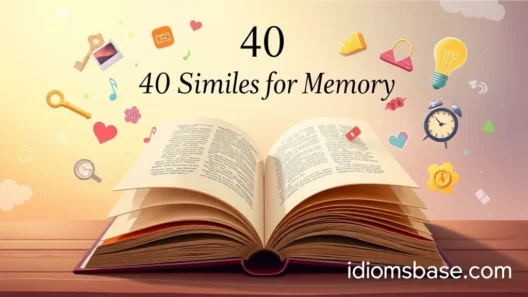Ever noticed how we describe things by comparing them to something else? It’s like magic, isn't it? Suddenly, a simple idea becomes vivid and memorable! We’re talking about similes, those fantastic figures of speech that use "like" or "as" to draw comparisons. And where do similes truly shine? In places where learning and creativity bloom – like school!
School can be a whirlwind of experiences, from the quiet hum of concentration to the buzzing energy of a playground. Similes help us capture these moments in a way that words alone sometimes can't. They make our descriptions richer, more relatable, and frankly, a lot more fun! Think about it: instead of just saying "the test was hard," you could say, "the test was as tough as nails." See the difference? It paints a picture!
In this exciting journey, we're going to explore some wonderful similes for school that can help you express yourself more clearly, creatively, and colorfully. Whether you're writing an essay, telling a story to a friend, or just trying to make sense of your daily school life, these similes are your secret weapon. Let's dive in and discover how you can make your language sparkle like a freshly cleaned blackboard!
Why Similes Are Your Best Friends in School
Similes aren't just for poets; they're incredibly useful tools for everyone, especially in a school environment. They can help you:
- Make your writing more vivid: Instead of bland descriptions, similes add a splash of color.
- Explain complex ideas simply: By comparing something new to something familiar, you can make it easier to understand.
- Engage your audience: Creative language keeps readers (and listeners!) hooked.
- Boost your vocabulary and critical thinking: Crafting good similes requires you to think deeply about connections between different things.
- Show, don't just tell: Similes are a fantastic way to illustrate a point without explicitly stating it.
Imagine trying to describe the feeling of anticipation before a field trip. You could just say, "I was excited." Or, you could say, "I was as excited as a kid on Christmas morning." The latter evokes a much stronger image and feeling, doesn't it? That's the power of similes!
Brilliant Similes for School Experiences
Let's explore some fantastic similes tailored for various aspects of school life. You'll find these useful for everything from creative writing assignments to everyday conversations.
Similes for Learning and Academics
Learning can be a smooth sail or a challenging climb. Similes help us describe these varied experiences.
- As clear as crystal: When a concept finally clicks and makes perfect sense.
- Example: "After the teacher explained it again, the math problem was as clear as crystal."
- Like a sponge: Describes someone who absorbs information quickly and easily.
- Example: "My little brother is like a sponge when it comes to learning new languages."
- As tough as nails: For a particularly difficult assignment, test, or problem.
- Example: "That history essay was as tough as nails; it took me hours to finish!"
- Like digging for treasure: When research or finding the right answer requires a lot of effort and perseverance.
- Example: "Finding that specific quote for my paper felt like digging for treasure."
- As easy as pie: When a task or concept is remarkably simple to understand or complete.
- Example: "Once I understood the formula, solving the equation was as easy as pie."
- Like a light bulb going off: Describes the moment of sudden understanding or an "aha!" moment.
- Example: "When the teacher drew the diagram, it was like a light bulb going off in my head."
- As dull as dishwater: For a boring lesson, lecture, or textbook.
- Example: "The lecture on ancient pottery was as dull as dishwater; I almost fell asleep."
Similes for Teachers and Teaching Styles
Teachers are central to the school experience, and their styles can be wonderfully diverse.
- Like a guiding star: For a teacher who provides excellent direction and inspiration.
- Example: "Our science teacher is like a guiding star, always helping us find our way through complex topics."
- As patient as a saint: Describes a teacher who is incredibly tolerant and understanding, especially with struggling students.
- Example: "Ms. Davis is as patient as a saint when explaining challenging concepts."
- Like a drill sergeant: For a very strict and demanding teacher.
- Example: "Our gym teacher is like a drill sergeant during warm-ups."
- As wise as an owl: For a teacher with deep knowledge and good judgment.
- Example: "Mr. Henderson, our philosophy teacher, is as wise as an owl."
- Like a storyteller: For a teacher who makes lessons engaging and memorable through narratives.
- Example: "Our literature teacher makes every book come alive; she truly teaches like a storyteller."
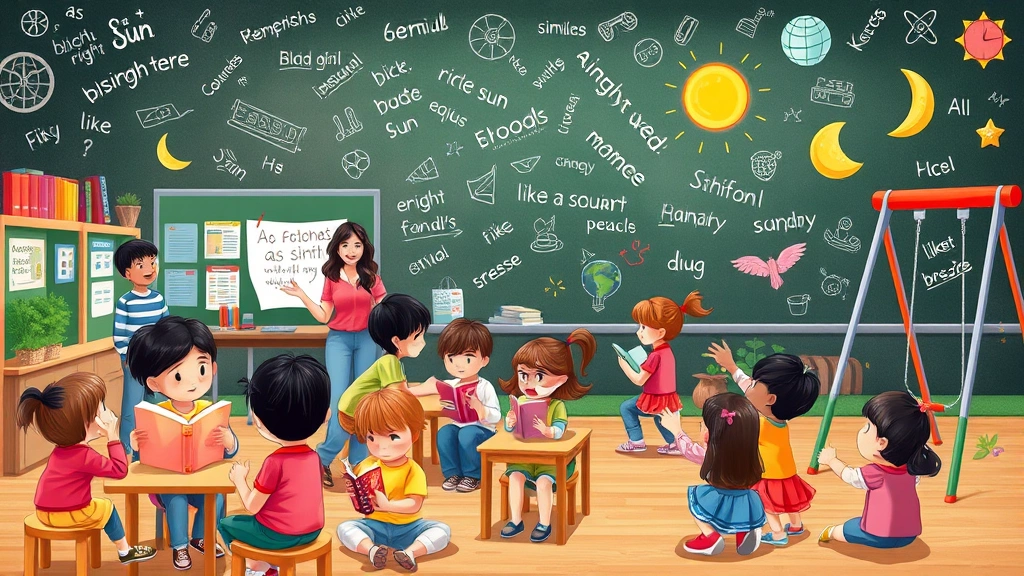
Similes for Students and Social Dynamics
The social world of school is rich with interactions and personalities.
- As quiet as a mouse: Describes a very shy or reserved student, or a silent classroom.
- Example: "During the exam, the classroom was as quiet as a mouse."
- Like a fish out of water: For someone feeling uncomfortable or out of place in a new environment or situation.
- Example: "On my first day, I felt like a fish out of water until I made some friends."
- As busy as a bee: Describes a very active, hardworking, or popular student.
- Example: "Sarah is as busy as a bee with all her extracurricular activities."
- Like two peas in a pod: For two friends who are very similar and get along extremely well.
- Example: "Liam and Chloe are like two peas in a pod; they do everything together."
- As cool as a cucumber: For a student who remains calm and composed under pressure.
- Example: "Even during the presentation, Alex was as cool as a cucumber."
- Like a pack of wolves: When a group of students acts together, sometimes aggressively or competitively.
- Example: "The debate team attacked the opposing arguments like a pack of wolves."
Similes for School Environment and Atmosphere
The school itself, from its hallways to its library, has its own unique feel.
- As noisy as a marketplace: Describes a bustling, loud hallway or cafeteria.
- Example: "During lunch break, the cafeteria is as noisy as a marketplace."
- Like a second home: For a school that feels welcoming, comfortable, and familiar.
- Example: "After so many years, this school truly feels like a second home to me."
- As bright as a new penny: For a freshly cleaned or renovated part of the school.
- Example: "The newly painted classrooms looked as bright as a new penny."
- Like a beehive: Describes a busy, active school full of students working and moving around.
- Example: "On the first day of school, the campus was like a beehive."
- As cold as a freezer: For an overly air-conditioned classroom or a chilly morning in school.
- Example: "Our classroom was as cold as a freezer this morning; I needed a sweater!"
Crafting Your Own Similes: A Mini-Guide
Now that you've seen some examples, ready to try your hand at creating your own? It's easier than you think!
Here's a quick table to help you brainstorm:
| Element to Describe (X) | Quality of X | Comparison (Y) | Simile Structure | Example |
|---|---|---|---|---|
| The principal's voice | Loud, booming | A thunderclap | X is like Y | The principal's voice was like a thunderclap over the intercom. |
| My backpack | Heavy | A sack of bricks | X is as [adjective] as Y | My backpack was as heavy as a sack of bricks. |
| The school play | Chaotic | A circus | X is like Y | The rehearsal for the school play was like a circus. |
Tips for Success:
- Identify what you want to describe (X): Is it a person, a feeling, an object, or an event at school?
- Think about its key characteristic: What stands out about X? Is it fast, slow, bright, dark, difficult, easy, loud, quiet?
- Brainstorm something else (Y) that shares that characteristic: What other things in the world are also fast, slow, bright, etc.? Try to think of unexpected or vivid comparisons.
- Use "like" or "as":
- "X is like Y."
- "X is as [adjective] as Y."
- Read it aloud: Does it sound good? Does it make sense? Is it impactful?
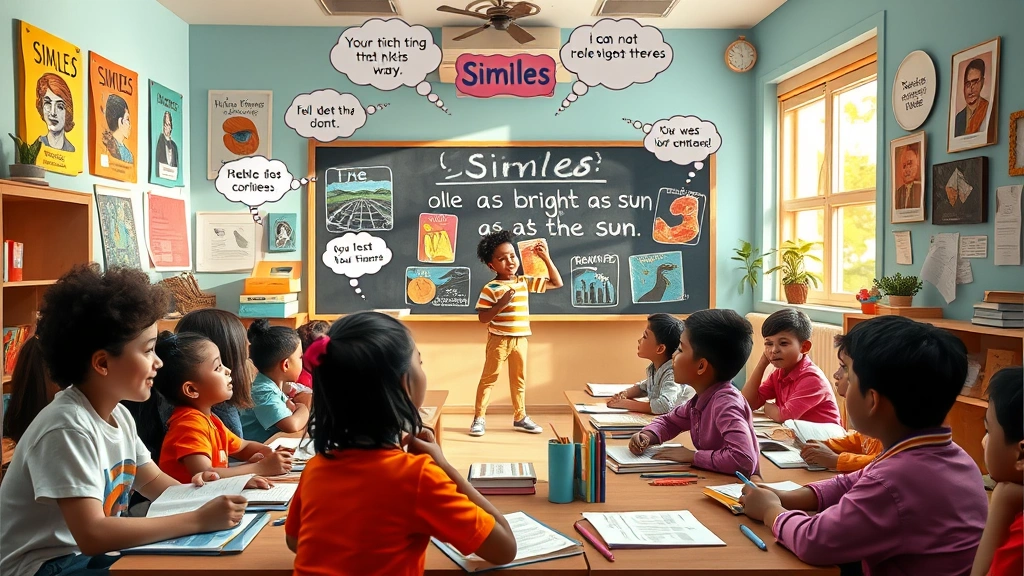
Don't be afraid to experiment! The most creative similes often come from surprising comparisons.
Key Takeaways
- Similes are powerful: They use "like" or "as" to compare two different things, making descriptions vivid and engaging.
- They enhance communication: Similes help you show, not just tell, making your writing and speech more impactful.
- School is a simile goldmine: From academic challenges to social interactions and the school environment itself, there are endless opportunities to use similes.
- Practice makes perfect: The more you try to create your own similes, the better you'll become at it.
- Be creative and specific: The best similes often draw on unexpected but apt comparisons.
Frequently Asked Questions (FAQs)
Q1: What exactly is a simile, and how is it different from a metaphor?
A1: That's a fantastic question! A simile is a figure of speech that directly compares two different things, explicitly using the words "like" or "as." The key here is the direct comparison with those specific words. For example, "The student was as busy as a bee."
A metaphor, on the other hand, also compares two different things, but it does so indirectly without using "like" or "as." It states that one thing is another, implying the comparison. For example, "The student was a busy bee." Here, the student isn't literally a bee, but the comparison is made directly without the connecting words. Think of it this way: a simile says something is like something else, while a metaphor says something is something else.
Q2: Why are similes important for students to learn?
A2: Similes are incredibly important for students for several reasons:
- Improved Writing Skills: They add richness, imagery, and originality to essays, stories, and reports, helping students paint clearer pictures for their readers.
- Enhanced Vocabulary and Language Comprehension: Understanding and creating similes requires a deeper grasp of word meanings and nuances.
- Boosted Creativity and Critical Thinking: Crafting effective similes encourages students to think creatively about connections between seemingly unrelated things.
- Better Communication: Similes allow students to express complex ideas or emotions in a more relatable and understandable way.
- Appreciation of Literature: Recognizing similes in books and poems helps students understand the author's craft and the deeper meanings within texts.
They truly help students become more articulate and imaginative communicators!
Q3: Can similes be used in formal academic writing, like research papers?
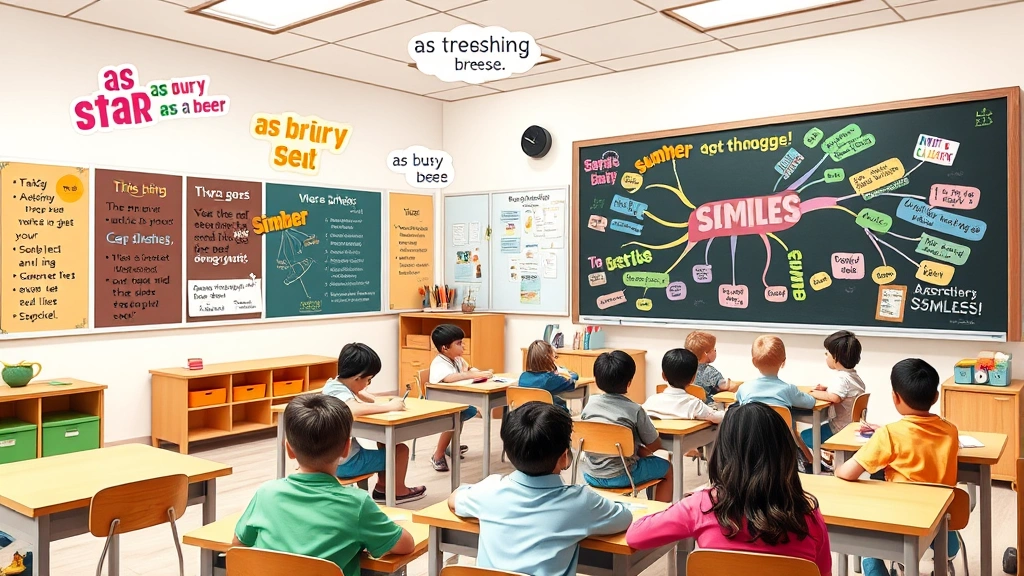
A3: This is a nuanced one! While similes are fantastic for creative writing, essays, and even some persuasive writing, their use in formal academic writing like research papers or scientific reports should be approached with caution.
In highly formal academic contexts, the primary goal is clarity, precision, and objectivity. Figures of speech, including similes, can sometimes introduce ambiguity or a subjective tone, which is generally avoided.
However, there are exceptions:
- When simplifying complex ideas: A well-chosen simile can sometimes help to explain a very abstract or difficult concept to a broader audience, as long as it doesn't sacrifice precision.
- In introductory or concluding sections: A compelling simile might be used sparingly in an introduction to hook the reader or in a conclusion to leave a lasting impression, provided it aligns with the overall tone.
- In disciplines where figurative language is accepted: Some humanities fields might be more open to carefully used figurative language than, say, a chemistry report.
General Rule: If you're unsure, it's usually best to err on the side of direct, literal language in formal academic writing. Save your most creative similes for less formal assignments!
Q4: How can I encourage my child to use similes in their school work?
A4: Encouraging the use of similes can be a fun and engaging process! Here are some ideas:
- Read Aloud Together: Point out similes in books you read. "Oh, listen! The author says 'the moon was like a silver coin.' What does that tell you about the moon?"
- Play "Simile Detective": Challenge them to find similes in songs, movies, or everyday conversations.
- "What's it Like?" Game: Pick an object (e.g., a cloud, a dog, a pencil) and ask them to describe it using "like" or "as." For example, "What is a cloud like?" "It's like a giant cotton ball."
- Describe Feelings: Help them articulate emotions using similes. "How did you feel when you won the game?" "I felt as light as a feather!"
- Focus on Observation: Encourage them to pay attention to details. The more they observe, the more comparisons they can draw.
- Don't Overcorrect: At first, focus on the attempt and the creativity, not just grammatical perfection. The goal is to build confidence.
- Lead by Example: Use similes in your own conversations! "This coffee is as hot as the sun!"
Making it a game or a creative challenge rather than a chore will make them more enthusiastic about exploring figurative language.
Q5: Are there any common mistakes to avoid when using similes?
A5: Yes, definitely! While similes are wonderful, some common pitfalls can make them less effective:
- Being Too Obvious or Clichéd: Avoid overused similes that have lost their impact (e.g., "busy as a bee" – though we used it here for illustration, try to be more original if possible!). Strive for fresh, unexpected comparisons.
- Making Inaccurate Comparisons: The two things being compared must genuinely share the quality you're highlighting. Don't say "the room was as quiet as a marching band."
- Overdoing It: Too many similes in one piece of writing can make it feel forced, cluttered, or even silly. Use them strategically for maximum impact.
- Being Vague: A good simile should clarify, not confuse. If your comparison isn't clear or doesn't immediately click with the reader, it might not be effective.
- Mixing Metaphors and Similes Carelessly: While related, be clear if you're using "like/as" for a simile or stating "is" for a metaphor. Inconsistent usage can be jarring.
The best similes are original, precise, and add genuine value to your description.
So, there you have it! Similes are truly like a secret ingredient for your language, making everything you say or write more flavorful and engaging. From describing a challenging test as tough as nails to capturing the quiet concentration of a classmate as quiet as a mouse, these powerful comparisons bring your words to life.
We hope this exploration has inspired you to sprinkle more similes into your school life and beyond. Remember, language is a playground, and similes are one of the most exciting swings on it! So go ahead, experiment, play, and make your words sparkle like a diamond! What's your favorite simile for school, or what new one can you create right now? Share your thoughts and let your creativity flow!



